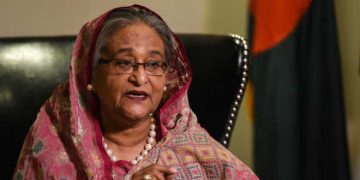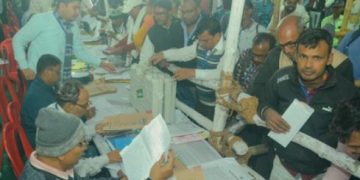Himanshu Guru
The formation of the province of Orissa became a reality April 1, 1936. After the defeat of King Mukunda Dev in the year 1568 erstwhile Orissa lost its freedom. The Oriya race lost its identity and was practically on the verge of being erased from the pages of regional history. They faced desperation and exploitation for centuries. Yet after the ill-fated ‘Naanka Durbhikshya’, the famine of 1866, the struggle for resurrection began that continued nearly for a period of 70 years and, at last, the long cherished dream of the creation of the province of Orissa became a reality April 1. Orissa is acknowledged as the first linguistic state in the entire country. To mark the legendary happening of history ‘Utkal Diwas’ is celebrated April 1 every year. Sunday POST tries to capture the mood ahead of Utkal Divas and presents glimpses of the historical formation of the state and the ideological contribution of the great freedom fighters.
A Chronicle
During c.150 CE, emperor Kharavela conquered a major part of the Indian subcontinent centering his kingdom in Orissa. Subsequently, the region was ruled by monarchs such as Samudragupta and Shashanka. The land was also a part of Harshavardhan’s empire. Later, the kings of the Somavamsi dynasty began to unite the region. During the reign of Yayati II, c.1025 CE, they had integrated the region into a single kingdom. They were replaced by the Eastern Ganga dynasty. Erstwhile Orissa was conquered by the Sultanate of Bengal. Mukunda Dev, who is considered the last independent king of Kalinga, was defeated and killed in battle by Ramachandra Bhanja in 1568 AD. Later, the British occupied the Northern Circars comprising the southern coast of Orissa as a result of the Second Carnatic War by 1760 and incorporated them into the Madras Presidency gradually, and the northern and western districts of the state were incorporated into the Bengal Presidency. During British rule in the 19th century, Orissa as well as the Oriya-spoken territories lay shattered.
The Great Famine of 1866
The terrifying famine of 1866 practically removed one third of the population from the mainland. Being placed in a valley of despair, shadow and frustration, Oriya identity was crushed to the point of extinction or obliteration. But the severe jolt aroused a sense of concern and a search for the identity of the Oriya race began in the form of agitation followed by unending unrests soon after the famine.
Formation of the Province
Beginning with the struggle in the year 1866 Orissa acquired the status of a province in 1936. By the year 1895 Orissa was the tenth southern division covering an area of 9,098 sq/miles in the mighty Bengal Presidency which covered an area of 1,33,597 sq/miles. The Orissa Division was constituted with the four districts of Cuttack, Puri, Balasore and Angul covering an area of 9,098 sq/miles. Besides these four districts, 17 feudatory states were also attached to the Orissa Division covering an area of 14,387 sq/miles with a population of 25,76,978. The 17 feudatory states were Athgarh, Baramba, Dhenkanal, Hindol, Khandpara, Narsingpur, Nayagarh, Nilgiri, Ranpur, Talcher, Tigiria, Baud, Daspalla, Keonjhar, Mayurbhanj, Athmallik and Pal Lahada.
Language Conflict
In 1896, Hindi was introduced in the Oriya-speaking district of Sambalpur as a part of the Chattisgarh Division of Central Province as the court and administrative language. This created anguished frustration among the people which fuelled in the people of the Western region the urgency of agitation. In this unstable period, the movement for the restoration of the Oriya language was spearheaded by Dharanidhar Mishra and other stalwarts and duly steered by Madhusudan Das. According to the 1931Census there were only 1.11 crore Oriyas. Back then, the eight top language speaking people were as follows: Hindi 41.41 crore, Bengali 5.34 crore, Telugu 2.63 crore, Maharastrian 2.08 crore, Tamil 2.04 crore, Panjabi 1.58 crore, Kannada 1.12 crore and Oriya 1.11 crore.
Madhusudan Das’s contribution
The eventful meeting of Madhusudan Das with Lord Curzon, the Viceroy of India, during the third week of October 1900 at Shimla brought big changes on the map of Orissa. The Risley Circular issued by Lord Curzon in 1903 contained a well-conceived concrete proposal for the amalgamation of disjointed and vivisected Oriya-speaking territories. As a part of implementation of this Circular, the district of Sambalpur covering an area of 3,724 sq/miles was merged with the Orissa Division, and with this merger the total geographic area of the Division went up to 13,659 sq/miles with a population of nearly 12,25,593! This brought a sigh of relief among the disgruntled Oriya people. But the outcome was not very encouraging. Against the loud proclamations made in the Risley Circular propounding the amalgamation of dismembered and the dissected Oriya-speaking territories under a single administrative control, the eagerly-awaited solution to Oriya problems was crushed down to the point of insignificance when the Orissa Division with its infinitesimal size was tagged to the wide stretching Bihar in 1912 to make the composite province of Bihar-Orissa. Orissa was the fifth southern dejected division of the state with a geographical area of 12,822 sq/ miles whereas the rest of the four divisions of Bihar namely Tirhut, Bhagalpur, Patna and Chottanagpur constituted an area of 42,360 sq/miles.
In these provinces, the voice of the minority Oriya people was submerged and practically lost its relevance and propriety. Even in Bihar-Orissa province, the fate of the Oriya people was doomed as the preponderant voice of the people was reduced to apartheid minority of insignificance.
The Mahatma’s intervention
In February 1920 Madhusudan Das conveyed a message to Mahatma Gandhi through the top-ranking Oriya leader Brajasundar Das attracting his benign attention to the intricate problem of vivisection of the Oriya-speaking territories. He tried to convince the great leader about the dismemberment of the Oriya people who were treated as a minority group in different states. He also raised the question whether modern India would be built on the ashes of the disintegrating mighty Oriya race. Gandhi responded to it by declaring his unequivocal decision regarding the formation of province on a linguistic basis. But despite his support to the cause, nothing firm could be achieved as no other national leader took any deep interest in the regard.
Then in 1928 Madhusudan Das again raised the issue before the Butler Committee at Bombay for the amalgamation of the Oriya feudatory states of Saraikela and Kharswan lying in the remote corner of Chottanagpur region of the Bihar-Orissa Province. As per the favourable recommendations of the Lothian Committee constituted for this purpose these two feudatory states were annexed to the Orissa Division in 1933.
Final Achievement
Despite the periodical recessions and setbacks, the struggle for the creation of a separate province for Orissa was fought with vigour and patience. A new hope was kindled with the setting up of the Statutory Commission headed by John Simon. A wind of change was blowing vigorously. The struggle which had almost ground to a halt soon acquired momentum when a delegation of Oriya representatives deputed by Madhusudan Das welcomed the Simon Commission at the Patna railway station on 12/12/1928 and submitted the memorial 14/12/1928.
A new leaf was turned in the history of the formation of the province of Orissa. Soon the entire process was seized by the forces of change when the matter was taken up in right earnest in the First and Third Round Table Conferences in London followed by serious deliberations at the Joint Parliamentary Committee meetings. Maharaja Krushnachandra Gajapati, Raja Ramachandra Mardraj Deo, Bhubanananda Das and others who actively participated in these proceedings did a praiseworthy and commendable job in this connection. With a strong determination of unfaltering trust they sincerely resolved the formidable problems and fulfilled the mission. Ultimately, the formation of the province of Orissa became a reality April 1, 1936.
Aftermath
The creation of the province of Orissa as the first linguistic province in the country aroused aspirations and enduring sentiments among the other linguistic groups. In fact, during the last week of April 1938 a resolution was adopted in the Madras Legislative Assembly for the creation of the four new provinces of Andhra, Tamil Nadu, Karnataka and Kerala out of the old Presidency of Madras. But the proposal met with a premature and untimely death when it was turned down by the British Parliament.
Soon after the independence of the country, a pattern was laid down for reorganisation of the states on a linguistic basis, as per the glorious tradition set by Orissa as the forerunner in the field. But the monumental history relating to the legendry creation of the province of Orissa has not yet been compiled.







































